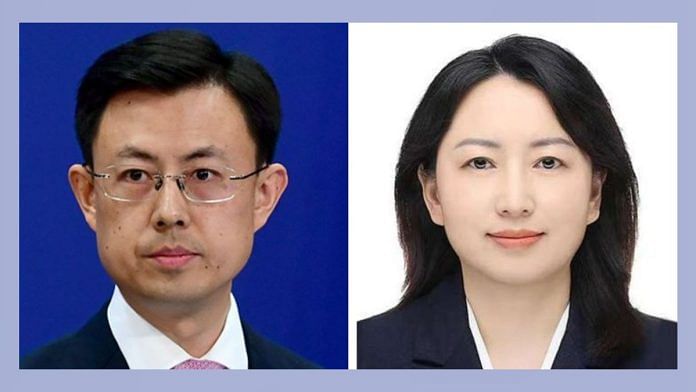New Delhi: The ongoing US-India spat has caught China’s attention. From the foreign ministry in Beijing to its embassy in India, Chinese officials have taken several potshots at the US for its imposition of tariffs, as well as the state of ties between New Delhi and Washington, D.C.
“China’s opposition to the abuse of tariffs is consistent and clear,” said Chinese foreign ministry spokesperson Guo Jiakun Thursday, responding to a question in connection with the imposition of additional tariffs of 25 percent on India by US President Donald Trump earlier this week.
The statement by Guo was posted by Yu Jing, the Chinese embassy spokesperson in New Delhi, on the social media platform X. Yu has been particularly active in the last few days, sharing statements in support of India, seemingly, as its ties with the US remain tense.
For a long time, New Delhi has been a key ally for the US and its Western partners, especially in their larger plan to check the rise of China as the sole power in the Indo-Pacific. Over the past few years, several organisations, such as the Quadrilateral Security Dialogue, incorporating the US, Australia, Japan, and India, and the I2U2, comprising the US, Israel, India, and the UAE, have been established, further embedding New Delhi in the larger multilateral system led by Washington, D.C.
However, ties between India and the US have seen setbacks with Trump taking aim at New Delhi’s continued purchase of Russian oil, accusing the country of supporting Moscow’s war machine. Furthermore, the American President is annoyed with the lack of progress in the negotiations for a trade deal between New Delhi and Washington, D.C.
“Give the bully an inch, he will take a mile,” Xu Feihong, the Chinese ambassador to India, said in a post on the social media platform X, sharing a quote from a conversation between Chinese foreign minister Wang Yi and Celso Amorim, the chief adviser to the President of Brazil.
In another post earlier Friday, Xu shared an image, comparing Chinese trade policies with those of the US. Xu asserted that Beijing had opened its markets to Brazil, highlighting approvals to 183 new Brazilian companies for export to the country. The US, in comparison, slapped a tariff on Brazilian coffee exports, Xu wrote.
“India’s sovereignty is non-negotiable and its foreign policy choices cannot be manipulated by other countries, no matter how significant their own ties with India are,” Yu shared in a post on X, quoting from an editorial in the newspaper, The Hindu.
Chinese embassy officials have been active on social media platforms over the last year. They usually share India-China and their historical ties. The embassy had, in the past, taken to social media to press the Indian government on changing its China policy, as well.
For instance, in July 2024, the Chinese embassy took to X to push India to resume direct air connectivity with it, which had been on pause since the COVID-19 pandemic. The embassy also urged New Delhi to resume tourist visas for Chinese nationals.
At the time, ties between India and China were tense due to unresolved issues stemming from the clashes at Galwan in the summer months of 2020. However, a couple of months later, both countries reached an agreement to disengage at the friction points across the Line of Actual Control (LAC), Foreign Secretary Vikram Misri announced on 21 October.
The disengagement agreement set the stage for Prime Minister Narendra Modi’s meeting with Chinese President Xi Jinping on 23 October in the Russian city of Kazan, on the margins of the BRICS summit. Since then, New Delhi and Beijing have introduced confidence-building measures to restore some semblance of normalcy in ties.
Last month, China’s embassy, along with its foreign ministry, apart from social media posts promoting BRICS, shared several posts on the potential resumption of Russia-India-China trilateral dialogues.
Modi will likely travel to China at the end of this month for the Shanghai Cooperation Organisation (SCO) summit of Heads of States. It would be his first visit to China since June 2018, when he visited the city of Qingdao in China for a former SCO summit.
(Edited by Madhurita Goswami)






